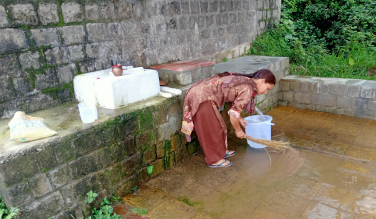
CORD Sidhbari, Himachal Pradesh CORD’s Community-led Springshed Management Interventions
Natural springs serve as the lifeline for rural communities in India, being not only a sustainable water source but also holding diverse cultural and social significance. Unfortunately, springs in the Himalayan region are continuously drying up due to unfair human interventions, a lack of ownership, and inadequate management initiatives. To combat this, CORD collaborated with the Government of Himachal Pradesh and pioneering organizations such as the Wheel Global Foundation, People Science Institute (PSI) Dehradun, Indian Institute of Technology-Roorkee, and Advanced Center for Water Resources Development and Management (ACWADAM)-Pune. Together, they implemented a pilot springshed management program in the Narwana Khas, Tang, and Andrad panchayats in the Dharamshala block of Kangra district.
As the program’s implementing agency, CORD engaged government departments like Forest, Jal Shakti, and Rural Development for targeted interventions. These included plantations, toe tranches, household soakage pits, and other soil and water conservation measures. Moreover, the program focuses on real-time data collection, training, and capacity building of water user groups, gram panchayat representatives, community institutions, and other stakeholders. CORD is also a key partner in the high-altitude springshed management program in the Tissa block of Chamba district, Himachal Pradesh, collaborating with PSI Dehradun and the International Centre for Integrated Mountain Development (ICIMOD).
CORD’s interventions have significantly increased community engagement in the ownership and monitoring of these springs. Under the springshed program, eighteen springs in the Kangra and Chamba districts are currently being rejuvenated. Seventeen water user groups have been formed, trained, and nurtured.
Plantation activities have been completed across 12 hectares of spring recharge areas in collaboration with the forest department. The recharge areas of selected springs saw the construction of 560 toe-tranches and 100 staggered contour trenches, which have effectively increased water discharge. The CORD team and trained community paraprofessionals consistently gather data on spring water discharge and quality. Additionally, water user groups adhere to protocols for cleanliness and effective spring management. Each group conducts monthly meetings to discuss issues and detailed activity plans. Furthermore, monthly spring worship by each group has fostered a deeper sense of belonging to these water resources.
Consequently, these springshed interventions have directly benefited approximately four hundred households, playing a crucial role in saving these vital water sources from disappearing.
